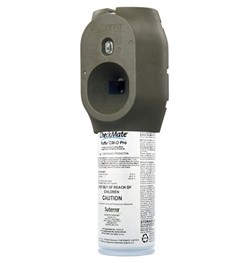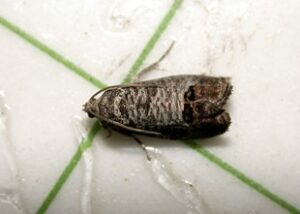Time flies and now we’re in May! I’m guessing that most fruit trees throughout the state are somewhere between bloom and petal fall, so now is the time for tree fruit producers to use mating disruption strategies against tree fruit pests, like codling moth and dogwood borer, especially if you’ve had issues with these insects in your orchards.
Some may be wondering if there’s a difference between pheromone traps and mating disruption for tree fruit insect pests and the answer is ‘yes!’ Although both strategies use attractive chemical cues to lure focal insects, in the case of pheromone traps an odor that mimics the smell of a female moth is used to attract adult males to traps where they are easily detected by you or a member of your team, so you know the pest is actively flying. This is especially helpful if you are tracking degree days to predict when eggs might be laid or when they will hatch. However, in mating disruption, the strategy is a bit different: the goal is to overwhelm the local environment (your orchard) with the smell of a female moth, so that males are “confused” and unable to find a female, or if they do, they are unable to perform normal courtship behavior, so mating does not occur. To give a human example, imagine your entire home, filled with the odor of French fries or popcorn (two of my favorites, ha!) and searching every room by smell alone to find a single fry or kernel – it would be challenging! This is the basic idea of mating disruption, except I’ve used food odor examples rather than pheromones, which are the focal odors used in mating disruption. Nevertheless, when applied properly and at the correct timing, mating disruption can stop reproduction altogether, so no eggs are laid, and no pests emerge to attack your fruits.

Figure 2. Example of a manual dispenser for codling moth mating disruption: CheckMate® CM-XL 2.0 Dispenser. Photo credit: Suterra.com

Figure 3. Example of an aerosol emitter for codling moth mating disruption: CheckMate® Puffer CM-O. Photo credit: Suterra.com
Mating disruption products may be manual dispensers (Figure 2) or sprayable and aerosol emitters that are hung from trees (Figure 3), or polymer mixtures that are applied as a dollop directly on the tree trunk or branch. These products can last from several weeks to several months. This is pretty amazing technology and can dramatically reduce the number of insecticide applications for key insect pests in your orchard as well!
The best time to apply mating disruption against the codling moth is during bloom, so depending on where you are in the state, it may be time now or it may be getting a bit late. The best time to apply mating disruption for the dogwood borer is bloom through petal fall. Last but not least, mating disruption is most likely to be successful in blocks of at least 5 acres and when deployed at the correct timing, so you truly stop mating and reproduction throughout the time period when moths are searching for mates. You can find more information about mating disruption products on page 27 of the 2021-2022 Midwest Fruit Pest Management Guide. As always, if you have questions about mating disruption strategies and products, reach out to your local extension educator or specialist so we can help!
